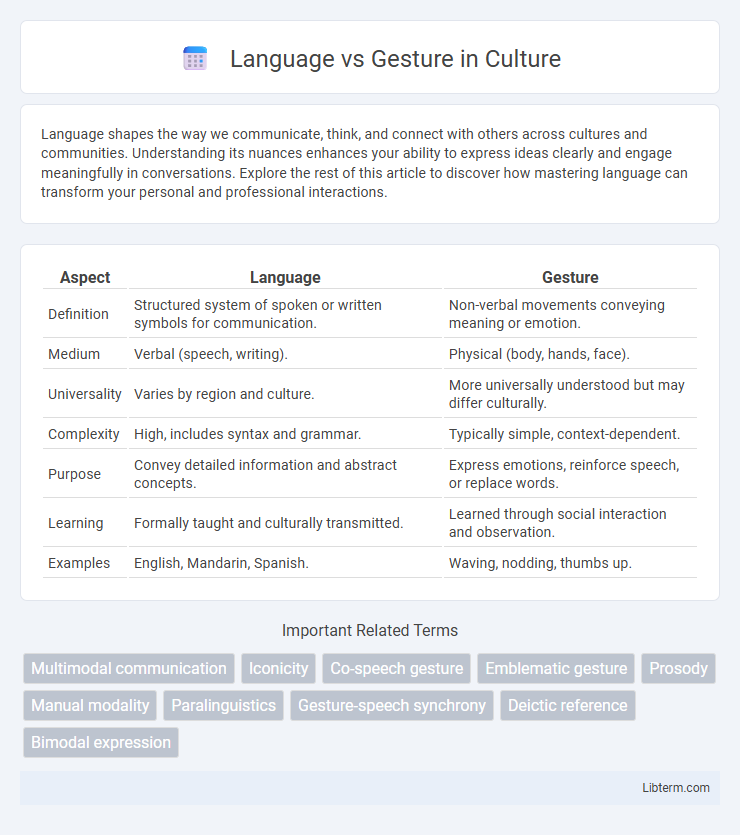Language shapes the way we communicate, think, and connect with others across cultures and communities. Understanding its nuances enhances your ability to express ideas clearly and engage meaningfully in conversations. Explore the rest of this article to discover how mastering language can transform your personal and professional interactions.
Table of Comparison
| Aspect | Language | Gesture |
|---|---|---|
| Definition | Structured system of spoken or written symbols for communication. | Non-verbal movements conveying meaning or emotion. |
| Medium | Verbal (speech, writing). | Physical (body, hands, face). |
| Universality | Varies by region and culture. | More universally understood but may differ culturally. |
| Complexity | High, includes syntax and grammar. | Typically simple, context-dependent. |
| Purpose | Convey detailed information and abstract concepts. | Express emotions, reinforce speech, or replace words. |
| Learning | Formally taught and culturally transmitted. | Learned through social interaction and observation. |
| Examples | English, Mandarin, Spanish. | Waving, nodding, thumbs up. |
Introduction: Defining Language and Gesture
Language is a structured system of symbols and rules used for communication, encompassing spoken, written, and signed forms. Gesture involves non-verbal movements, primarily of the hands and body, to convey meaning or emotion without spoken words. Both serve as fundamental modes of human interaction but differ in their reliance on verbal elements and cultural conventions.
Historical Perspectives on Communication
Early communication systems evolved from primitive gestures to complex spoken languages, highlighting the transition from nonverbal to verbal modes of expression. Ancient civilizations relied heavily on gestures and symbolic signs before formal language structures emerged, as evidenced in cave paintings and early writing systems like cuneiform and hieroglyphics. Linguistic anthropology traces how language development aligned with cognitive advancements, social organization, and cultural transmission across human history.
The Science Behind Verbal and Nonverbal Communication
Verbal communication relies on structured language systems processed primarily in the brain's left hemisphere, engaging areas such as Broca's and Wernicke's regions to encode and decode syntax and semantics. Gesture, a form of nonverbal communication, depends on visual-spatial processing found in the right hemisphere, involving motor cortices to convey meaning through hand movements, facial expressions, and body posture. Neuroscientific studies reveal that language and gesture are integrated during communication, with multimodal interactions enhancing clarity, context, and emotional nuance beyond words alone.
Cognitive Processing: Understanding Language vs. Gesture
Language involves complex symbolic systems processed primarily in the left hemisphere of the brain, engaging areas such as Broca's and Wernicke's regions to decode syntax and semantics. Gesture processing activates a broader network, including the right hemisphere, premotor cortex, and mirror neuron system, facilitating the interpretation of nonverbal cues. Cognitive understanding of language emphasizes structured linguistic rules, whereas gesture comprehension relies on context, spatial awareness, and embodied simulation.
Cross-Cultural Variations in Gesture and Language
Cross-cultural variations in gesture and language reveal distinct communication styles shaped by cultural norms and values, influencing both verbal and non-verbal interactions. For instance, the thumbs-up gesture signifies approval in Western cultures but may be offensive in parts of the Middle East, while language structure and idiomatic expressions vary widely, affecting mutual intelligibility. Understanding these differences is crucial for effective intercultural communication, reducing misunderstandings, and promoting social cohesion in diverse settings.
Gesture as a Universal Language?
Gestures serve as a universal language by conveying meaning across diverse cultures through nonverbal cues such as hand movements, facial expressions, and body postures. Unlike spoken language, gestures transcend linguistic barriers, enabling effective communication in situations where language differences exist or verbal communication is impossible. Research shows that gestures play a crucial role in social interactions, enhancing clarity, emotional expression, and understanding globally.
The Role of Gesture in Language Development
Gesture plays a crucial role in early language development by serving as a bridge between nonverbal communication and verbal expression. Research shows that children's use of gestures predicts vocabulary growth and facilitates the acquisition of complex linguistic structures. Integrating gesture into language learning enhances cognitive processing and supports the emergence of syntactic and semantic skills.
Language and Gesture in Social Interaction
Language and gesture serve as complementary channels in social interaction, with language primarily conveying explicit information through structured syntax and vocabulary, while gestures provide contextual and emotional cues that enhance communication. Research in cognitive linguistics highlights that gestures often regulate conversational flow and emphasize key points, facilitating mutual understanding in social exchanges. The integration of verbal language and nonverbal gestures forms a multimodal communication system essential for effective interpersonal connection and social bonding.
Technology’s Impact on Language and Gesture
Technology profoundly influences language and gesture by integrating digital communication tools that reshape traditional interactions. Voice recognition systems and AI-driven translators enhance verbal communication, while augmented reality and motion sensors capture and interpret gestures for more immersive user experiences. This convergence promotes new hybrid forms of expression, blending spoken language with dynamic gestures to streamline human-computer interaction.
Future Directions: Integrating Language and Gesture
Future research in integrating language and gesture emphasizes the development of multimodal communication systems leveraging artificial intelligence and natural language processing. Advances in neural interfaces and gesture recognition technology aim to create more intuitive human-computer interaction paradigms by combining spoken language with real-time gesture interpretation. Emerging applications include enhanced virtual reality environments, assistive communication devices, and improved machine translation models that contextualize gestures for deeper semantic understanding.
Language Infographic

 libterm.com
libterm.com